The Chantry is the dominant religious organization in Thedas. It is based on the Chant of Light, a series of teachings written by Andraste, the prophet of the Maker, and was founded by Kordillus Drakon, the first emperor of Orlais. Its followers are known as Andrastians. "Chantric" is also an acceptable adjective to refer to something or someone that is of the Chantry religion.
The Chantry's goal is to spread the Chant of Light to all four corners of the world, that includes non-humans as well. The view of the Chantry on non-humans is that they need saving—they have turned even further from the Maker's grace than humanity has. There are no known Andrastian Qunari; the elves worshipped, and in some cases still worship, the Elven pantheon; and dwarves venerate the Stone. Once all peoples have accepted the Chant and practice its teachings, supposedly the Maker will return to the world and return it to its former glory. As such, Andrastian religion in Thedas can be described as deistic in that the world (or Thedas at least) was abandoned by the Maker and he will not heed prayer or perform any other function until his favor is regained.
The Chantry calendar is used everywhere in Thedas, save for the Imperium, and is the source of the names of the Ages.
History
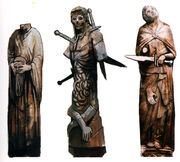
When Andraste died a martyr, around her legend grew a cult known as the Cult of the Maker.[2] It had no central leadership[3] and its followers were oppressed.[4] The clerics had to hide their lore from Tevinter magisters by way of ciphers and encoded scrolls.[5] In -130 Ancient they collected Andraste's teachings into hymns, creating the Chant of Light and the cult popularity spread.[6]
The cult remained fragmented until it was formalized into the Chantry by Kordillus Drakon, the first Emperor of the newly formed Orlesian Empire, in -3 Ancient. He established Andrastianism as the national religion and was himself a fervent believer in the Maker. Three years later the first Divine, Justinia I, was declared. Drakon's military successes during the Second Blight significantly expanded the borders of Orlais, and soon after the conquered lands converted to the faith. While these lands would later liberate themselves from Orlesian rule following Drakon's death, the religious practice remained.
The Antivan Crows started as an arm of the Chantry. In the hills north of Treviso, an order of monks used the herbs grown in the gardens of their abbey to oppose the rule of a despotic duke in the only manner they could.[7]
During the Towers Age there was debate in the Chantry over whether Andraste was truly divine. It was largely the Imperial Chantry's belief that she was not divine that led to the schism in the Chantry and the eventual founding of the Imperial Chantry as a separate religion in 3:87 Towers.[8][9]
With so much influence over the people, the Chantry can also exert considerable political pressure on the ruling classes in many areas of concern. In extraordinary times, and in deference to Andraste, the Divine may also be moved to declare an Exalted March. These religious crusades have mobilized armies of thousands to destroy the heretical enemies of the Maker. The first March after Andraste's death being against the elves of the Dales.[10] The next four were against Tevinter, and the most recent led against the Qunari; that time, Tevinter also took part in the march.[11]
With start of Mage-Templar War in 9:40 Dragon the Chantry lost control over the Circles of Magi, Templar Order and the Seekers of the Truth.
At an undefined later stage of the war, the head of the Chantry and the head of the Mage's faction meet at the Temple of Sacred Ashes for peace talks. There, a massive explosion occurs, creating the breach in the sky and ushering in a rash of Veil Tears throughout the area. The Chantry--according to Mike Laidlaw until that point the "the thing keeping the lid on the pot of Thedas"[12]--succumbs to absolute chaos in its leadership.[13]
Chantry hierarchy
- See also: Codex entry: Chantry Hierarchy
The actual priesthood of the Chantry is made up entirely of women, on the basis that Andraste was a woman. At the head of the Chantry is the Divine, who leads from her seat in the Grand Cathedral of Val Royeaux. Below her are the Grand Clerics who are the Chantry's highest authority in a country or a region. After a Divine dies, Grand Clerics are also the ones who are required to travel to Val Royeaux for the Grand Consensus, a meeting where they should unanimously elect the new leader of the Chantry. Beneath them are the mothers, who are responsible for administering to the spiritual well-being of their flock. If a mother is in charge of a local Chantry, she is called as a revered mother. Beneath them are the brothers and sisters and they consist of three main groups: affirmed, initiates, and clerics. This is the only rank that men are allowed to have. The initiates take vows and receive an academic education. Those who seek to become templars receive a martial education in addition. Clerics are the scholars of the Chantry and the most senior of them receive the title of "elder", which is, however, beneath that of mother.
Practices
The funeral rites of the Chantry involve cremation. As Andraste's body was burned, and her spirit ascended to stand by the Throne of the Maker, so too will that of her followers. It may also be to ward off the possibility of the corpse becoming the subject of demonic possession.
The pyres of peasants are often small and ringed with stones. Such burnings occur within the settlement, despite the fire risk, rather than at a distance.[14]
The Chantry hosts a "ten-year gathering", in which devote pilgrims journey to the Grand Cathedral in Val Royeaux to pray for peace.[15]
Chantries in Thedas
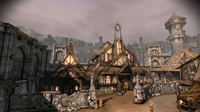
The Denerim cathedral
Members of the Chantry often worship in buildings called chantries. These chantries are present in almost every village, town and city and some will also maintain a Chanter's Board. At most chantries a religious character can receive a blessing or agree with the faithful. A non-religious character can disagree with the faithful, refuse a blessing or refuse to donate coin.
Chantries deliver practical services to the community, caring for the sick and collecting alms for the poor. The Chantry provides hospitality to travelers and a public network of communications. Should an illiterate commoner need to send word to another town, the Chantry's educated priests write and send the letter for him.
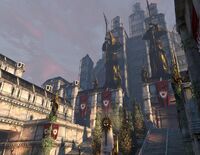
The Kirkwall chantry
- Lothering chantry, Lothering (destroyed by the darkspawn in Dragon 9:30)
- Denerim Cathedral, Denerim Market District
- Chantry of our Lady Redeemer, City of Amaranthine (this chantry can be destroyed, depending on player choices)
- Village Chantry, Redcliffe Village (this chantry can become abandoned, depending on player choices)
- Haven Chantry, Village of Haven (this chantry is not part of the Andastrian Chantry as it is operated by the Disciples of Andraste)
- Orzammar chantry, Orzammar Commons (this chantry can be prevented from ever forming, depending on player choices)
- Alternatively, a Circle of Magi outside of the Chantry's control can be established depending on player choices.
- Abandoned Chantry, Forlorn Cove (this abandoned site can be the scene of bloodshed, depending on player choices)
- Kirkwall Chantry, Kirkwall (destroyed by Anders in Dragon 9:37)
- Grand Cathedral, Val Royeaux
- Chantry of the Stilled Tongue, a "maniac splinter cult" of the Andrastian Chantry, with a preemptive perspective on sin[16]
- Andraste's Ear, a small Chantry in "the Dregs," a working-class Denerim neighborhood[17]
Chapels
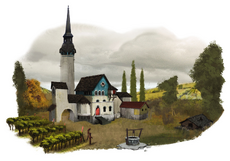
A countryside chapel in Orlais[18]
Chapels are located in larger self-contained buildings for the convenience of their inhabitants. These mostly include castles, forts and the Circle of Magi. At all chapels a religious character may receive a blessing or participate in a prayer to the Maker. A non-religious character can disagree with the faithful or refuse a blessing.
- Fort Drakon, Denerim (blessing is only available if using the disguise method of escape during Captured!)
- Castle Cousland, Highever (blessing and prayer is only available to the Human Noble Origin)
- Redcliffe Castle, Redcliffe (blessing only available after the castle's problems have been solved.)
- Kinloch Hold, Lake Calenhad (prayer only available in Magi Origin)
- Ostagar, southern Ferelden (blessing is only available during the first visit)
Related codex entries
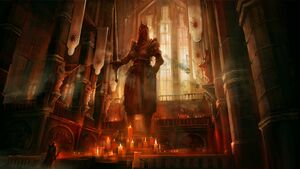
A Chantry altar
![]() Codex entry: The Founding of the Chantry
Codex entry: The Founding of the Chantry
![]() Codex entry: The History of the Chantry: Chapter 1
Codex entry: The History of the Chantry: Chapter 1
![]() Codex entry: The History of the Chantry: Chapter 2
Codex entry: The History of the Chantry: Chapter 2
![]() Codex entry: The History of the Chantry: Chapter 3
Codex entry: The History of the Chantry: Chapter 3
![]() Codex entry: The History of the Chantry: Chapter 4
Codex entry: The History of the Chantry: Chapter 4
![]() Codex entry: The Imperial Chantry
Codex entry: The Imperial Chantry
![]() Codex entry: Andraste: Bride of the Maker
Codex entry: Andraste: Bride of the Maker
References
- ↑
 Dragon Age: The World of Thedas, vol. 1, p. 125
Dragon Age: The World of Thedas, vol. 1, p. 125
- ↑
 Dragon Age: The World of Thedas, vol. 1, p. 46
Dragon Age: The World of Thedas, vol. 1, p. 46
- ↑
 Dragon Age: The World of Thedas, vol. 1, p. 113
Dragon Age: The World of Thedas, vol. 1, p. 113
- ↑ Prima Official Game Guide: Dragon Age II (Extras -> DA Encyclopedia -> Races and Religion -> Humans).
- ↑ According to Sister Justine during quest The Scrolls of Banastor.
- ↑
 Dragon Age: The World of Thedas, vol. 1, p. 49
Dragon Age: The World of Thedas, vol. 1, p. 49
- ↑ Bioware Wiki. Assassin on BioWare wiki
- ↑ Based on Imperial Reinforced Gloves description.
- ↑
 Dragon Age: The World of Thedas, vol. 1, p. 88
Dragon Age: The World of Thedas, vol. 1, p. 88
- ↑ This led to the decree of Divine Renata I to create Alienages as well as to destroy any Chantry art in Orlais depicting elves, save a single original mural of Shartan with his ears cropped. A copy exists at the University of Orlais.Amazon.com preview of The Masked Empire.
- ↑ Prima Official Game Guide (Collector's Edition), p. 256
- ↑ E3 2014 IGN Inquisition Demo.
- ↑ http://www.ausgamers.com/features/read/3432915
- ↑ Dragon Age: The Masked Empire, pg. 189.
- ↑ Dragon Age: Dawn of the Seeker
- ↑ Green Ronin. Blood in Ferelden tabletop RPG expansion, page 82.
- ↑ Green Ronin. Blood in Ferelden tabletop RPG expansion, page 83.
- ↑
 Dragon Age: The World of Thedas, vol. 1, p. 57
Dragon Age: The World of Thedas, vol. 1, p. 57
| ||||||||||||||||||||||||



